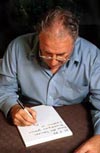
|
|
Low Vision
The effects of low vision are not the same for all people. Differences occur in:
- the amount of vision for distant and near object
- the visual field
- the ability to see print or objects which have poor contrast
- colour vision
- the effects of light on vision.
Factors that affect how well a person can see and recognise objects include:
- whether objects are familiar or strange
- distance of objects
- size of objects
- detail or simplicity of the object
- amount of light on the object
- contrast against the background
- colour of the object
- whether objects are still or moving
- how easy the object is to find
- position of the object
- time available for looking.
A person may have low vision from birth. However some conditions which result in low vision begin during childhood or later.
It is important to encourage people with low vision to use vision. They may not be aware that useful information can be gained from looking. This often happens when a person has a great change in vision or when children have low vision from birth.
Children with low vision from birth or a very early age are sometimes not aware that their vision is limited and different from other people's vision.
During early childhood most learning occurs through the use of vision. When vision is impaired, learning and communication may be affected.
Over time the level of low vision may stay the same. Sometimes the condition may get worse, but it does not always end in total blindness.
It may take some time to get used to an improvement or decrease in vision. Provide assistance and encouragement when vision changes.
Reactions to losing vision vary. Some people try to make no changes to how and what they do. Other people withdraw from all activities completely.
People react differently to a person with low vision. It is important to try to understand the effects of low vision for each person and what to expect them to be able to do.
With some eye conditions, a person sees better in the shade, out of bright light. With other eye conditions, the person needs bright light to see better.
People with low vision often need more time to do activities that rely on vision than people with normal vision.
When using vision for long periods, the person with low vision may become tired more quickly than other people. Suggest that the person takes short rests and then continues with the activity.
Some people with low vision see larger objects better and find it useful to use large print for reading. However, larger objects are not always the best for some people. Other factors such as the distance to the object, amount of light, colour and contrast make objects easier to see.
The eyes cannot be damaged by using vision or holding things close to the eyes. The more vision is used, the better is the chance of improving visual functioning.
Low vision is not the only reason for differences in how people progress and develop. Other disabilities, intelligence and different learning experiences affect how each person performs. It is important to know what each person can do and how he uses his vision in different activities and situations.
Checkpoint: Examine the following pictures for implications that may arise if a person with low vision views them. Think about familiarity or unfamiliarity, size of objects, complexity of images in the picture, areas of good or poor contrast, confusing detail.
|
|
| Visual Communication Unit |




